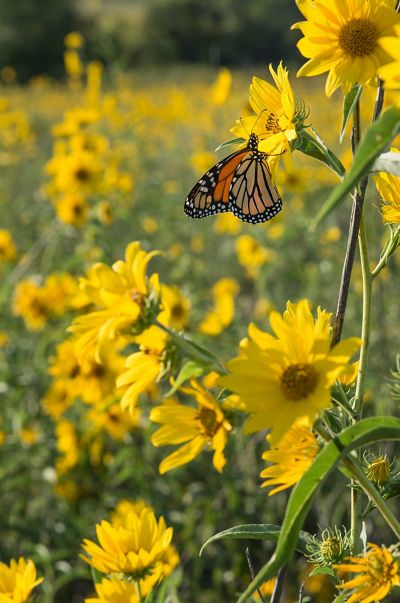Fish and Wildlife Proposes to List Monarch Butterfly as Threatened Species
Recommendation would bring some habitat protections if finalized.
Media Contacts
-
Eric Bontrager
Associate Director of Communications, North America Policy
The Nature Conservancy
Phone: 703-887-0559
Email: eric.bontrager@tnc.org
The U.S. Fish and Wildlife Service today recommended listing the monarch butterfly as a threatened species under the federal Endangered Species Act, with a final decision expected sometime next year.
The iconic orange and black butterfly, found in every continental U.S. state, has been in decline for years due to habitat loss, climate change and agriculture pesticide use. Researchers estimate that 970 million monarchs have vanished since 1990.
The species status assessment and recommendation announced today calls for the species to be listed as threatened under the ESA, which means the population is likely to become endangered in all or a significant portion of its range in the foreseeable future. The service has also proposed a special rule, known as a 4(d), which allows the agency to apply only protections of the ESA that are necessary for the conservation of the butterfly.
Official listing of the monarch as threatened would trigger protections for some of its critical habitats across the United States. The public comment period runs until March 12, 2025, meaning it will be up to the Trump administration whether to finalize the listing.

The following is a statement by Sarah Murdock, senior director for U.S. lands and water policy at The Nature Conservancy:
“The monarch butterfly is a North American icon, with its yearly migration up and down the continent remaining one of nature’s most stunning displays. The butterfly’s decline is yet another warning light about the worsening state of our natural world. It must also be a call to action for all of us to the challenges of habitat loss and climate change impacting species not just in North America but across the globe.
“Collaboration between all who may be impacted by this decision to implement this recommendation will minimize potential disruptions to the work and ways of life in the monarch’s habitats. We are committed to working with the Fish and Wildlife Service and others to forge a path forward that ensures a future where people and nature thrive together.”
The Nature Conservancy is a global conservation organization dedicated to conserving the lands and waters on which all life depends. Guided by science, we create innovative, on-the-ground solutions to our world’s toughest challenges so that nature and people can thrive together. We are tackling climate change, conserving lands, waters and oceans at an unprecedented scale, providing food and water sustainably and helping make cities more sustainable. The Nature Conservancy is working to make a lasting difference around the world in 81 countries and territories (40 by direct conservation impact and 41 through partners) through a collaborative approach that engages local communities, governments, the private sector, and other partners. To learn more, visit nature.org or follow @nature_press on X.



